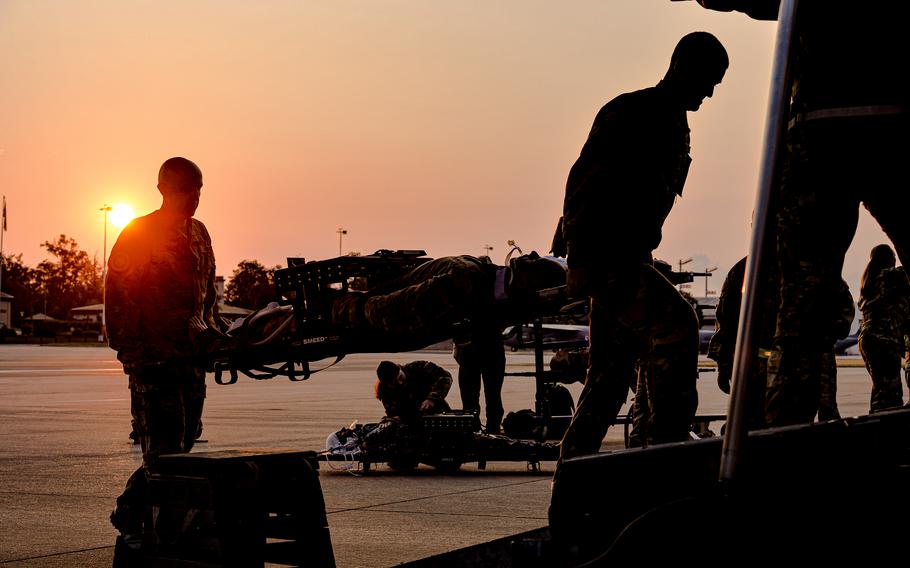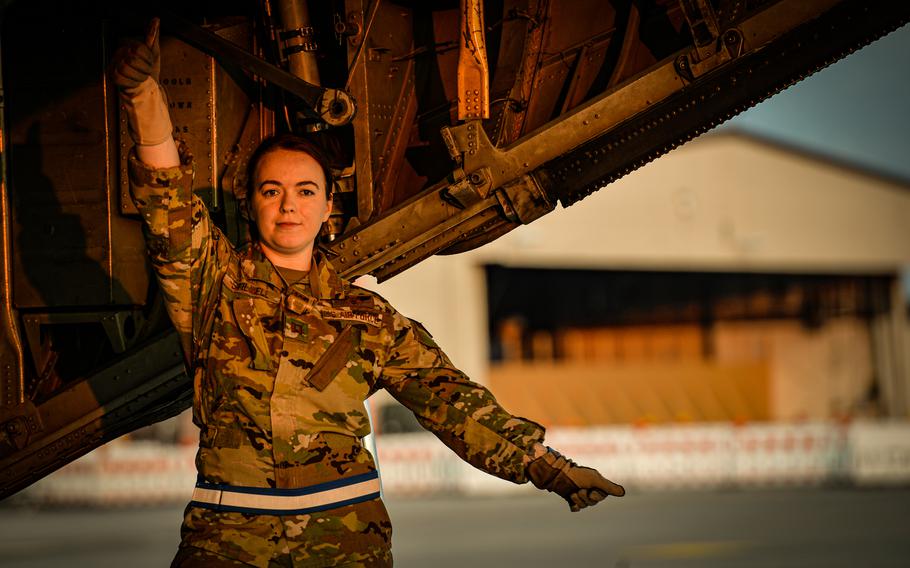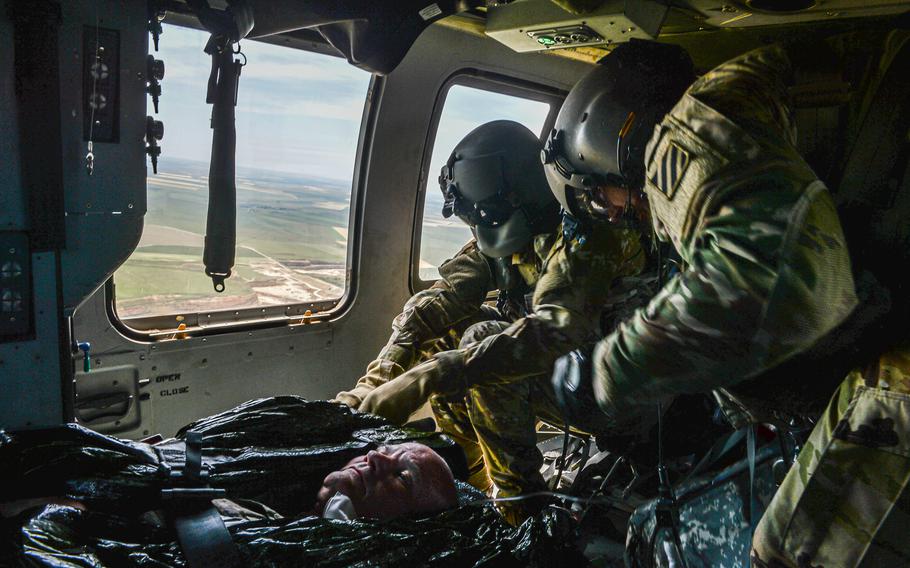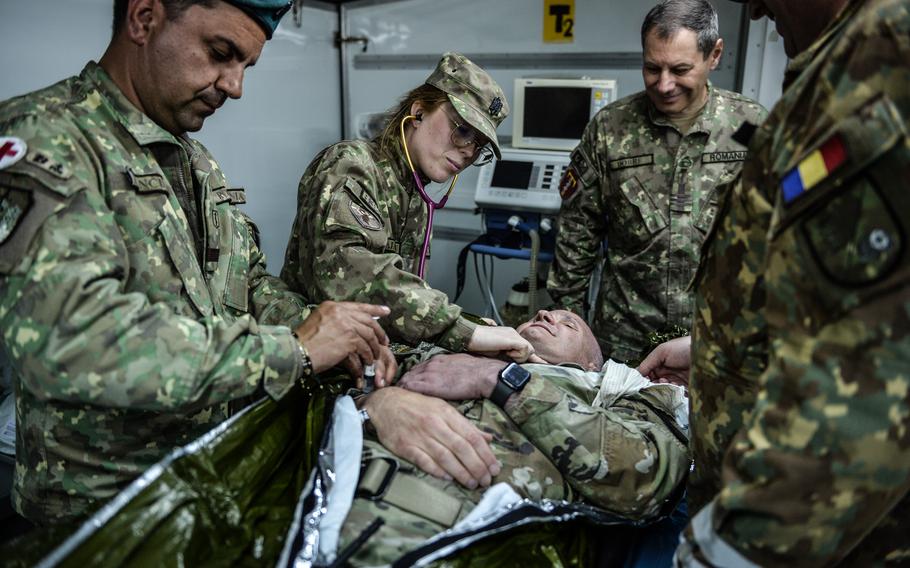Europe
US military medics’ dry run of future conflict triage takes them from Germany to Romania and back
Stars and Stripes June 7, 2023

Members of the Air Force's 86th Medical Squadron board a C-130 Hercules with a medical training mannequin June 6, 2023, at Ramstein Air Base, Germany, as part of Saber Guardian 23. The exercise took medical evacuation teams to Romania and back to Germany on a simulated patient care flight. (Alexander Riedel/Stars and Stripes)
About two dozen U.S. service members and a Polish aeromedical evacuation team piled into an American C-130 around dawn Tuesday at Ramstein Air Base in Germany for a six-hour round trip to retrieve a handful of mock casualties from Romania.
It was a long way to go for a small patient load, which included an “injured” mannequin military working dog, but the training flight signifies a paradigm shift for military medicine, participating U.S. personnel said.
Army Brig. Gen. Clinton Murray, commanding general of Medical Readiness Command, Europe and command surgeon, said that when he was a major deployed to Iraq 20 years ago, patients he saw in Ramadi could be airlifted to San Antonio in less than 72 hours.
“That will not happen in a large-scale combat operation, wherever it is around the world,” he said.

Air Force Capt. Samantha Stilwell, 86th Aeromedical Evacuation Squadron medical crew director, gives litter-bearers the go-ahead to board a C-130H Hercules during a medical evacuation exercise June 6, 2023, at Ramstein Air Base, Germany. (Alexander Riedel/Stars and Stripes)
During the wars in Iraq and Afghanistan, military medical teams could move the wounded quickly to military care in theater and on to Landstuhl Regional Medical Center in Germany, the Defense Department’s largest hospital overseas.
The most critically injured could be returned stateside in less than three days.
But such speed and ease of transport from the battlefield to life-saving treatment are unlikely in the next conflict because of the presumption that casualty numbers will be higher, and airspace will be contested, the medical officials said.
In Europe, Army medics and Air Force critical care air transport teams are preparing to do triage in a contested environment, “with the expectation of more prolonged field care,” Murray said.
For airlifts, that preparation includes using a variety of aircraft with smaller medical teams and training with partner nations.
Pentagon leaders have said they expect the next war to be a more intense fight against an adversary with capabilities similar to those of the U.S.
“We know it’s not going to be in Afghanistan; it’s not going to be in Iraq,” said Col. Scott Tonko, U.S. Air Forces in Europe-Air Forces Africa medical operations division chief and command nurse. “We have different adversaries now, and we need to prepare for that.”
When the Montana Air National Guard C-130 landed at Mihail Kogalniceanu Air Base in Romania, Murray, played the role of a patient.
U.S. and Romanian medics treated him with a tourniquet and bandages at a deployment-style camp in the fields near Bordusani. A short ambulance ride later, he was in a Black Hawk helicopter, receiving care while en route to a more advanced field hospital, where he was prepped for mock surgery.

Soldiers carry Brig. Gen. Clinton Murray from a UH-60 Black Hawk helicopter to a medical field hospital near Bordusani, Romania, on June 6, 2023, during Exercise Saber Guardian. (Alexander Riedel/Stars and Stripes)
He ended up back on the C-130 with several other soldiers pretending to be casualties. There were also three mannequin patients, two humans and one canine.
While on the ground in Romania, the C-130 kept its engine running as American and Polish aeromedical evacuation specialists prepared the patients for flight in a strip of grass near the runway.
During the return flight, the medics treated the lifelike mannequins like real patients.
Maj. Marcin Kunicki, head of the Polish aeromedical evacuation team, said exercises with the U.S. and other NATO partners are important for his team of 10 because they are his country’s only aeromedical evacuation specialists and have no other contemporaries to train with back home.
The training flight to and from Romania was part of a nearly three-week long medical exercise, Hospex, led by the Army’s 30th Medical Brigade.

Sgt. 1st Class Christopher Carney, a paramedic with the 23rd Aviation Regiment, and his flight engineer simulate treatment on Army Brig. Gen. Clinton Murray near Bordusani, Romania, on June 6, 2023. The simulation was part of Exercise Saber Guardian. (Alexander Riedel/Stars and Stripes)
It’s tied to the Army’s Saber Guardian combat exercise and the larger Defender 23, wide-scale military training being staged across Europe until June 23 with more than 20,000 personnel from roughly 20 nations.
Air Force Col. Vanessa Moses, the 86th Aeromedical Evacuation Squadron commander at Ramstein, was on the flight to Romania and on the exercise sidelines at Mihail Kogalniceanu Air Base.
“What we’re doing is a knowledge exchange with Romania (and Poland) to ensure that we’re ready for whatever may happen in the east,” she said. “It’s nice to see that our partners already know what to do in peacetime, because whenever there is action, we don’t have to figure that piece out. The time to figure that piece out is right now.”
After landing at Ramstein, Murray and the other patients were taken to Landstuhl Regional Medical Center. The initial care he received in the field was “spot on” for leg and lung injuries, he said.
“Absolutely I think I would have survived on that battle space,” he added.
Stars and Stripes reporter Alexander Riedel contributed to this report.

Romanian army medical technicians treat mock injuries on U.S. Army Brig. Gen. Clinton Murray near Bordusani, Romania, on June 6, 2023. Murray played the victim of severe combat trauma. (Alexander Riedel/Stars and Stripes)